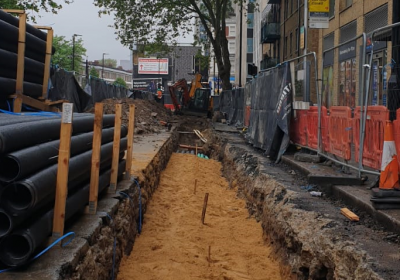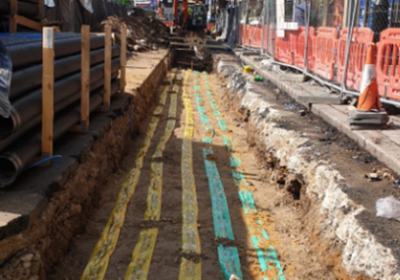TfL, boroughs, developers, utilities are investing to improve London’s infrastructure to support sustainable growth and a strengthened economy. 38 opportunity and intensification areas, such as Blackfriars Road, Elephant & Castle, Old Oak Common and Vauxhall & Nine Elms, have been identified to accommodate a rising population.
Maintaining the resilience and functionality of the road network during this transformation, including enabling the utility requirements associated with developments, is a complex challenge. The more we can do to plan and design-in future needs for utility requirements the more we are able to ‘future-proof’ the roads and, for example, avoid digging up the same road space on multiple occasions. This is especially important where there are facilities for pedestrians and cyclists e.g. footways and cycle tracks.
In 2012, through the Lane Rental Scheme, TfL started charging works promoters for occupying the busiest roads at the busiest times. This incentivises behaviour change and minimises highway occupation. The surplus funds that TfL receives from Lane Rental can be used on activities intended to reduce disruption and the other adverse effects of roadworks which can be applied on all London road networks. An example of where such funds have been utilised is for the Baylis Road scheme in Lambeth.
The Baylis Road scheme aims to improve safety for pedestrians and cyclists and involves 600 metres of physically segregated cycle lanes, raised crossings, floating bus stops and new surfacing between Lower Marsh and Westminster Bridge Road.
TfL and LBL assessed the risk of future works along Baylis Road associated with adjacent development areas and identified specific locations of intense activity and therefore the likelihood of the project being disrupted by future utility works.
Working closely with Michael Mee Ltd (MMUSS) a utility specialist, TfL and LBL council has been able to amend the design of the project to include an accessible duct network and facilitate future capacity and connections for nearby planned developments.
The design was submitted to the Lane Rental Funding board which was assessed, deemed a worthy project and funds granted. Orbital Civil Engineering were contracted via CVU to implement the works which commenced mid-2019 and completed June 2020.
- Project benefits: the future proofing works were carried out within the civil/resurfacing schedule and with minimal additional costs and impact on programme. Material savings were made by constructing the cycle segregation works on top of the trench works.
- Highway authority benefits: maintaining network resilience, reducing congestion, improving bus journey waiting time, reducing future works in the carriageway/cycle tracks/footways, reduced impacts to local economy, air quality, vulnerable road user safety and improved public perception.
- Utility supplier benefits: a facility ready for use which benefits the client (booking road space for works can be a lengthy process). Reduced costs – excavation for a 400 m single trench could be in the region of £250,000. The duct capacity in Baylis Road accommodates eight visits with the total saving of over £2million excluding additional impacts.
To find out more, click the link below.
Did you find this article helpful?
Please rate this article

Loading...











